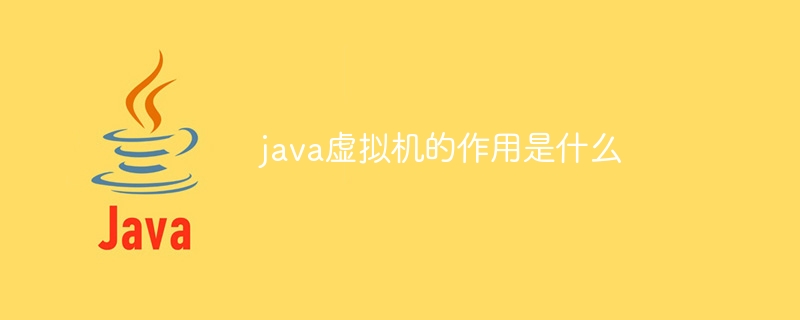What is the role of java virtual machine
The main functions are: 1. Achieve cross-platform functionality; 2. Provide memory management; 3. Execute bytecode; 4. Provide security; 5. Performance monitoring and tuning. Detailed introduction: 1. Achieving cross-platformness: The Java virtual machine enables Java programs to run on different operating systems because it acts as an intermediate layer between Java code and specific hardware/operating systems. Java programs only need to be compiled once, and then can be run on any system with the corresponding JVM installed; 2. Provide memory management: JVM is responsible for memory allocation, garbage collection, etc.

Operating system for this tutorial: Windows 10 system, Dell G3 computer.
The Java Virtual Machine (JVM) is one of the key components of the Java programming language. It plays multiple roles. Its main functions include the following:
Achieve cross-border Platformability: The Java Virtual Machine enables Java programs to run on different operating systems because it acts as an intermediary layer between the Java code and the specific hardware/operating system. Java programs only need to be compiled once and can then be run on any system with the corresponding JVM installed.
Provide memory management: JVM is responsible for memory allocation and garbage collection. It automatically manages memory, including allocating the memory needed for objects, tracking which objects are no longer in use, and performing garbage collection to free up memory space.
Execute bytecode: Java source code is first compiled into bytecode, and then interpreted and executed by the JVM or compiled by a just-in-time compiler (JIT). machine code execution. This approach can improve program performance.
Provide security: JVM ensures that Java applications run in a secure environment through the Security Manager. It controls access to system resources (such as files, networks, etc.) to prevent malicious behavior.
Performance monitoring and tuning: JVM provides a wealth of tools and APIs that can be used to monitor application performance and perform tuning to improve code execution efficiency and memory utilization. .
Overall, the Java Virtual Machine allows developers to write code once and execute it on multiple platforms, while providing key functions such as memory management, security, and performance optimization. This makes Java one of the popular cross-platform programming languages.
The above is the detailed content of What is the role of java virtual machine. For more information, please follow other related articles on the PHP Chinese website!

Hot AI Tools

Undresser.AI Undress
AI-powered app for creating realistic nude photos

AI Clothes Remover
Online AI tool for removing clothes from photos.

Undress AI Tool
Undress images for free

Clothoff.io
AI clothes remover

AI Hentai Generator
Generate AI Hentai for free.

Hot Article

Hot Tools

Notepad++7.3.1
Easy-to-use and free code editor

SublimeText3 Chinese version
Chinese version, very easy to use

Zend Studio 13.0.1
Powerful PHP integrated development environment

Dreamweaver CS6
Visual web development tools

SublimeText3 Mac version
God-level code editing software (SublimeText3)

Hot Topics
 Square Root in Java
Aug 30, 2024 pm 04:26 PM
Square Root in Java
Aug 30, 2024 pm 04:26 PM
Guide to Square Root in Java. Here we discuss how Square Root works in Java with example and its code implementation respectively.
 Perfect Number in Java
Aug 30, 2024 pm 04:28 PM
Perfect Number in Java
Aug 30, 2024 pm 04:28 PM
Guide to Perfect Number in Java. Here we discuss the Definition, How to check Perfect number in Java?, examples with code implementation.
 Random Number Generator in Java
Aug 30, 2024 pm 04:27 PM
Random Number Generator in Java
Aug 30, 2024 pm 04:27 PM
Guide to Random Number Generator in Java. Here we discuss Functions in Java with examples and two different Generators with ther examples.
 Weka in Java
Aug 30, 2024 pm 04:28 PM
Weka in Java
Aug 30, 2024 pm 04:28 PM
Guide to Weka in Java. Here we discuss the Introduction, how to use weka java, the type of platform, and advantages with examples.
 Armstrong Number in Java
Aug 30, 2024 pm 04:26 PM
Armstrong Number in Java
Aug 30, 2024 pm 04:26 PM
Guide to the Armstrong Number in Java. Here we discuss an introduction to Armstrong's number in java along with some of the code.
 Smith Number in Java
Aug 30, 2024 pm 04:28 PM
Smith Number in Java
Aug 30, 2024 pm 04:28 PM
Guide to Smith Number in Java. Here we discuss the Definition, How to check smith number in Java? example with code implementation.
 Java Spring Interview Questions
Aug 30, 2024 pm 04:29 PM
Java Spring Interview Questions
Aug 30, 2024 pm 04:29 PM
In this article, we have kept the most asked Java Spring Interview Questions with their detailed answers. So that you can crack the interview.
 Break or return from Java 8 stream forEach?
Feb 07, 2025 pm 12:09 PM
Break or return from Java 8 stream forEach?
Feb 07, 2025 pm 12:09 PM
Java 8 introduces the Stream API, providing a powerful and expressive way to process data collections. However, a common question when using Stream is: How to break or return from a forEach operation? Traditional loops allow for early interruption or return, but Stream's forEach method does not directly support this method. This article will explain the reasons and explore alternative methods for implementing premature termination in Stream processing systems. Further reading: Java Stream API improvements Understand Stream forEach The forEach method is a terminal operation that performs one operation on each element in the Stream. Its design intention is






